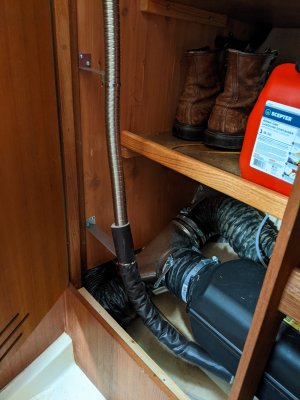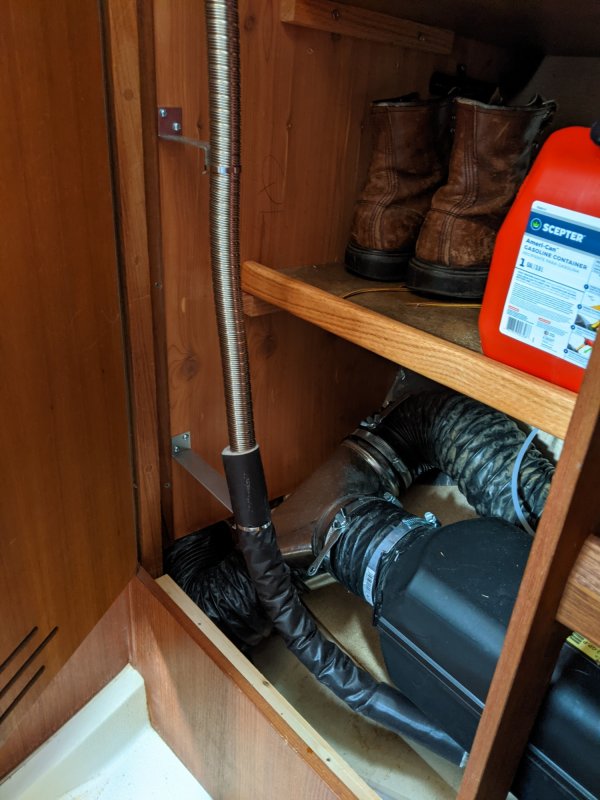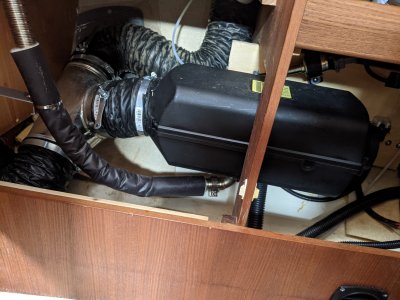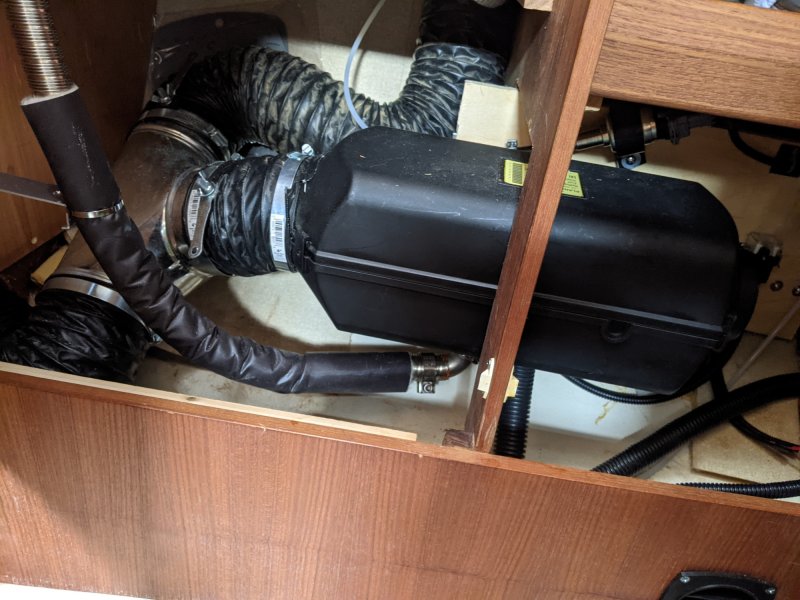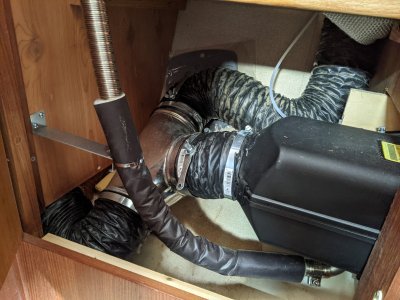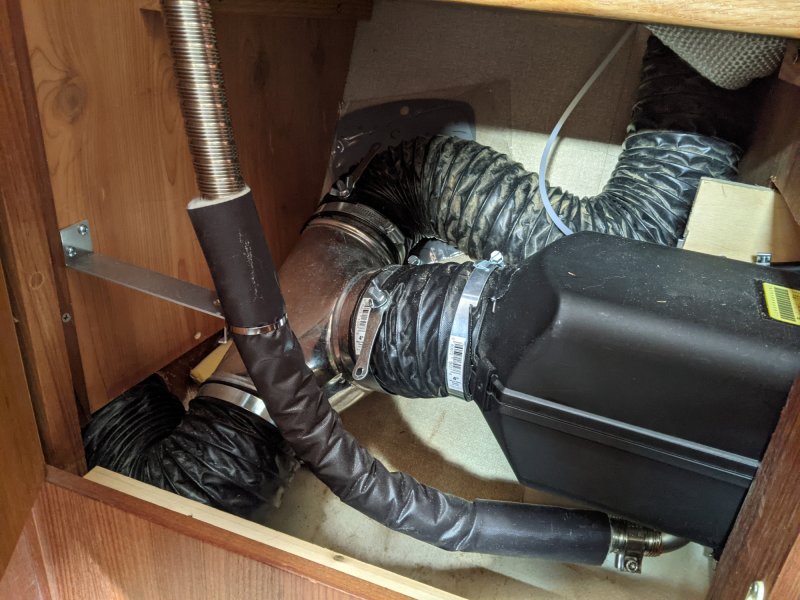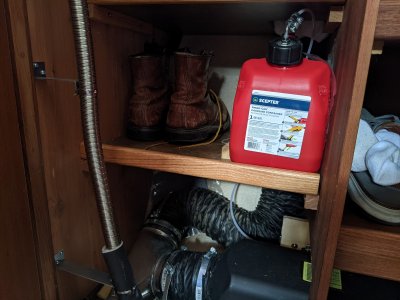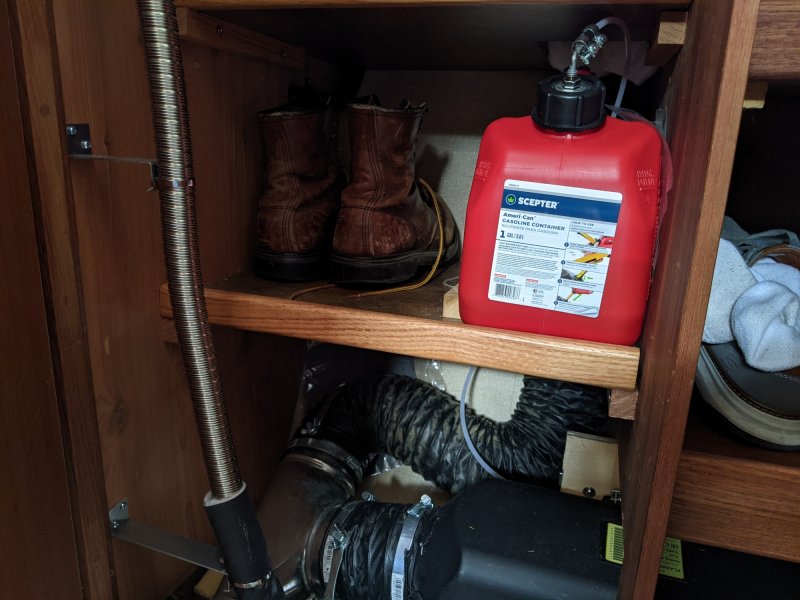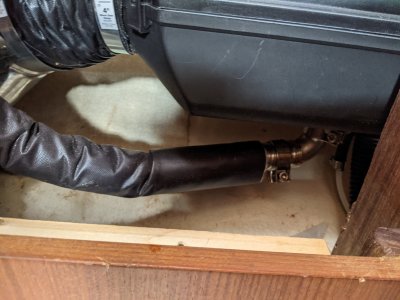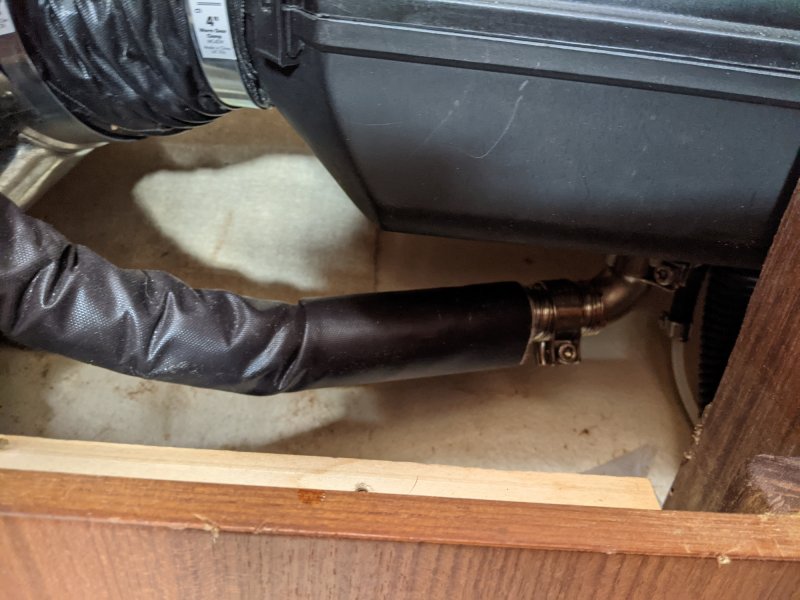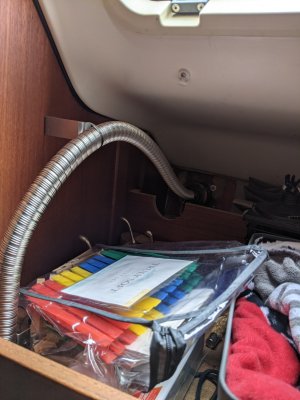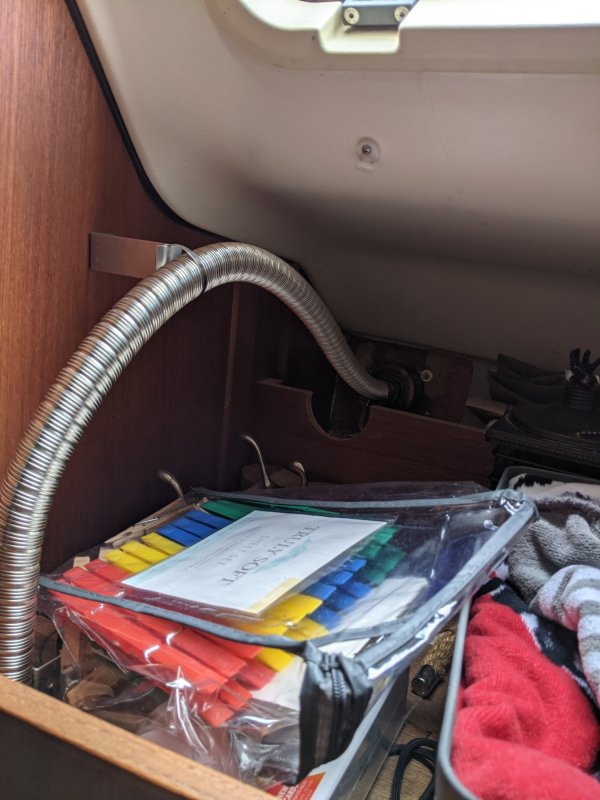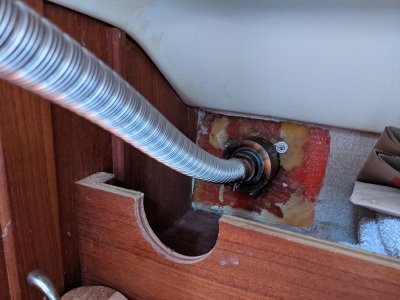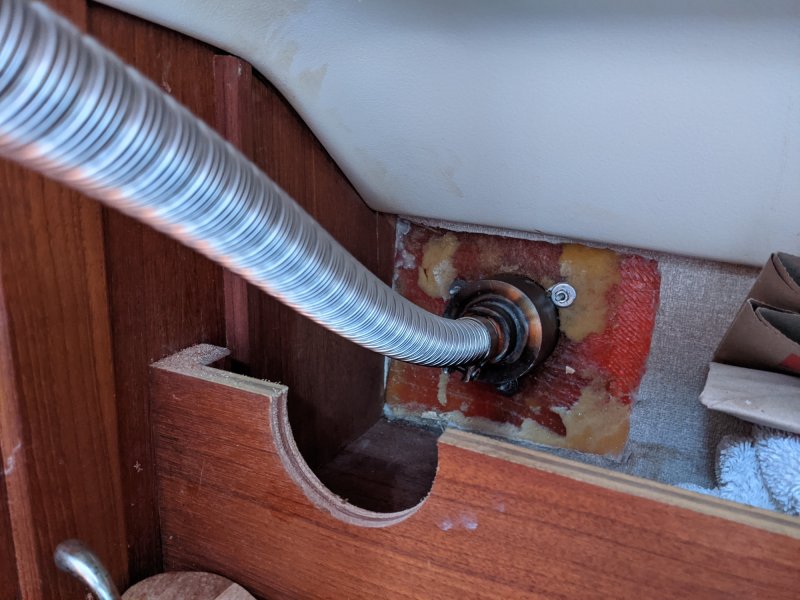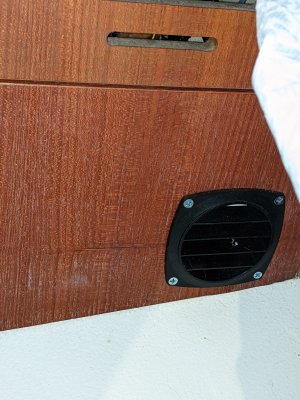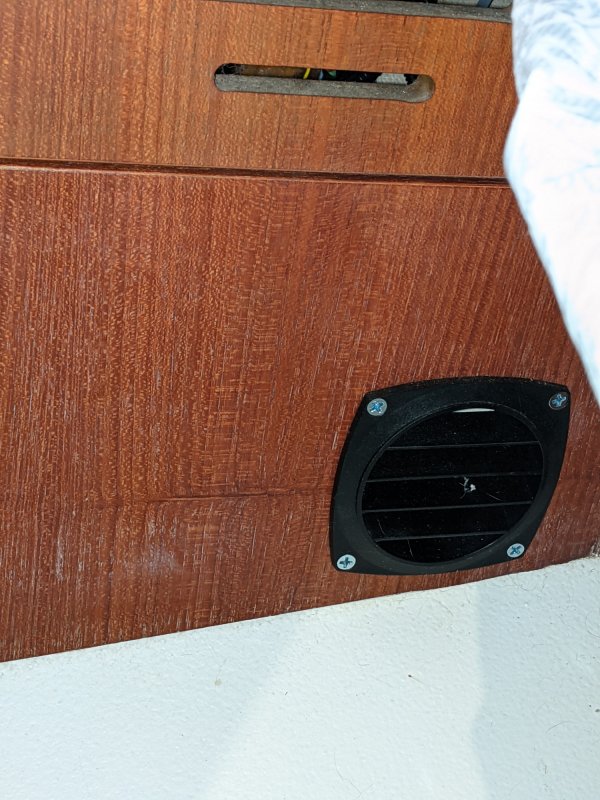Hunter OEM Parts
General Marine Parts
Diesel Heater in Hunter 376
posted 10-02-2021 by duck21
Our boat, At Last, already had an air conditioner with an reverse-cycle heater. However, the AC only works when connect to shore power. We wanted to add a diesel heater for heating while under way or anchoring out.
We purchased a Planar 44-D heater. The heater puts out up to ~13,000 BTU of heat, enough to heat a boat up to 40 feet (according to the brochure).
The kit came with all the needed installation hardware and with a fuel pump. I did need to purchase ducting to splice into the existing ducting, as well as exhaust pipe and the exhaust through hull. The kit came with a fuel tank but the design did not fit in the space, so I purchased a one gallon jerry can style tank.
I installed the heater in the aft cabin port-side locker. The previous owner had installed shelving in the locker--I removed the bottom shelf and cut a gap for the heater to fit. I mounted a board behind the heater to attach the shelf and the fuel pump.
We purchased a Planar 44-D heater. The heater puts out up to ~13,000 BTU of heat, enough to heat a boat up to 40 feet (according to the brochure).
The kit came with all the needed installation hardware and with a fuel pump. I did need to purchase ducting to splice into the existing ducting, as well as exhaust pipe and the exhaust through hull. The kit came with a fuel tank but the design did not fit in the space, so I purchased a one gallon jerry can style tank.
I installed the heater in the aft cabin port-side locker. The previous owner had installed shelving in the locker--I removed the bottom shelf and cut a gap for the heater to fit. I mounted a board behind the heater to attach the shelf and the fuel pump.
In this picture you can see the fuel pump mounted behind the heater. The wiring is coiled behind the mounting board. The DC power wiring is run from the locker through the wall to the galley (under the stove), forward to the settee where it then turns, goes through the top of the bilge, through the battery compartment and up to the electrical panel.
I cut into the ducting that lead to the aft cabin vent. I added in-line baffles between the T and the heater to keep AC air flow from flowing into the heater. This baffle is opened when the heater is in use. I added a baffle in the run up to the aft cabin for when the heater is in use--this allows us to regulate the air flow into the aft cabin when using the heater, increasing air flow to the main cabin and the VBerth vents.
The heater control is run up to the out-side of the locker next to the aft cabin berth headboard. This allows for easy control in the morning. This heater does NOT have a thermostat, so there was no concern about heating one space and not the others.
I cut into the ducting that lead to the aft cabin vent. I added in-line baffles between the T and the heater to keep AC air flow from flowing into the heater. This baffle is opened when the heater is in use. I added a baffle in the run up to the aft cabin for when the heater is in use--this allows us to regulate the air flow into the aft cabin when using the heater, increasing air flow to the main cabin and the VBerth vents.
The heater control is run up to the out-side of the locker next to the aft cabin berth headboard. This allows for easy control in the morning. This heater does NOT have a thermostat, so there was no concern about heating one space and not the others.
I placed the fuel tank on the shelf above. The kit came with a fuel pick-up tube. I modified the cap to hold the fuel pick-up tube. The fuel line runs over the back of the tank, down to below the shelf to the pump, which then runs behind and under the heater to the fuel connection.
The heater can run on #1 diesel, #2 diesel, or kerosene. I have been burning kerosene as it burns a little cleanly and lessens the chance of creating soot which can later lead to additional maintenance needs on the heater.
The heater can run on #1 diesel, #2 diesel, or kerosene. I have been burning kerosene as it burns a little cleanly and lessens the chance of creating soot which can later lead to additional maintenance needs on the heater.
The flexible exhaust line comes up and out of the heater then is zip-tied to stand offs leading up the inside door of the locker. This line does get quite hot, so I used insulation for the bottom portion to ensure that anything set on the floor doesnt roll against it and melt/burn. The zip ties are stainless steel to ensure they are heat resistant
I ran a fairly high gooseneck at the top of the exhaust run in order to ensure water will never back flow into the pipe and down to the heater.
The through-hull is triple walled to ensure it does not get too hot when the heater is running. When I run the heater the outside wall of the through-hull stays cool to the touch.
I plan on adding a contoured wood piece to the top shelf to ensure that things cant slide over against the exhaust pipe, but I have not yet created/installed that piece.
The through-hull is triple walled to ensure it does not get too hot when the heater is running. When I run the heater the outside wall of the through-hull stays cool to the touch.
I plan on adding a contoured wood piece to the top shelf to ensure that things cant slide over against the exhaust pipe, but I have not yet created/installed that piece.
I notched the top piece of wood when installing thinking the pipe may bend closer--however, in the final pipe run this as probably not needed.
I had to cut away the wall foam from the area around the exhaust through-hull. I used exhaust clamps and sealant at all joints to ensure that no CO leaks when the heater is running. I also mounted a CO detector IN the closet as a first-line of defense when the heater is running.
I had to cut away the wall foam from the area around the exhaust through-hull. I used exhaust clamps and sealant at all joints to ensure that no CO leaks when the heater is running. I also mounted a CO detector IN the closet as a first-line of defense when the heater is running.
I chose to let the heater use cabin air for both the combustion intake and the heating intake (this is hotly debated--using outside air for the heating intake will probably keep the cabin dryer, but also makes the heater work harder when heating cold air AND requires an additional through-hull).
I added a vent to the base of the locker to ensure that it could pull enough air into the space when the doors are closed.
I added a vent to the base of the locker to ensure that it could pull enough air into the space when the doors are closed.

